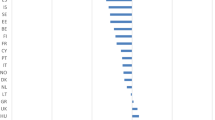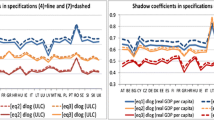Conclusion
According to the indicators used here, the German population has a particularly high level of education in international comparison and thus is likely to continue to earn high incomes in international competition. However, this standing will be jeopardised if education policy in Germany does not stand up to the challenges. There is a serious need for action. What is needed is a twofold strategy consisting of reforms to increase efficiency and higher funding to further improve the performance of the education system. A policy of this kind would lead the way to long-term growth opportunities and could even be cost neutral if the required extra spending were financed by reducing the subsidies which conserve the present structure9. However, a higher deficit in public budgets would also be acceptable as a means to finance additional spending on education, training and further training, given that these are investments which will pay off in later years.
Discussions on the wage dispersion by level of education in Germany often overlook the fact that it corresponds to the average for OECD countries. The greater the influence of additional education on individual income levels, the greater is the justification for private funding of the costs of education. This applies in particular to third-level education. Third-level graduates who were able to study free of charge in the past and are now earning high incomes could participate during a transition period in financing the costs of third-level education today.
Similar content being viewed by others
References
The following analysis draws on results from the report prepared for the Federal Ministry of Education, Science, Research and Technology (BMBF) on Germany's technological efficiency; cf. DIW: Berichterstattung zur technologischen Leistungsfähigkeit Deutschlands 1997. Documentation: Bildungsausgaben in Deutschland. Humankapitalbildung im internationalen Vergleich, Berlin, März 1998. Some of the results can also be found in the joint report prepared by the four participating institutes; cf. NIW/DIW/ISI/ZEW: Zur technologischen Leistungsfähigkeit Deutschlands 1997 extended update, Hanover/Berlin/Karlsruhe/Mannheim, December 1997.
In Germany, primary-level schooling consists of grades 1 to 4 (primary schools), secondary level covers grades 5 to 13 (lower-secondary schools, integrated comprehensive schools, intermediate-secondary schools, upper-secondary schools and vocational schools) and third level encompasses all subsequent education (technical colleges, specialised technical colleges and universities). A distinction is made within secondary level between lower-secondary (up to grade 10, i.e. the end of compulsory schooling) and upper-secondary (up to grade 13, i.e. matriculation, dual training, etc.).
OECD, Education at a Glance, Paris, 1997, table A 2.2a.
DIW, loc. cit.: Berichterstattung zur technologischen Leistungsfähigkeit Deutschlands 1997. Documentation: Bildungsausgaben in Deutschland. Humankapitalbildung im internationalen Vergleich, Berlin. März 1998. Some of the results can also be found in the joint report prepared by the four participting institutes; cf. NIW/DIW/ISI/ZEW: Zur technologischen Leistungsfähigkeit Deutschlands. 1997 extended update, Hanover/Berlin/Karlsruhe/Mannheim, December 1997. p. 35.
Barring insignificant exceptions, the data encompass public and private spending on initial training, including R&D at universities and excluding health services provided by university clinics.
For details of the calculations, see DIW, loc. cit., Berichterstattung zur technologischen Leistungsfähigkeit Deutschlands 1997. Documentation: Bildungsausgaben in Deutschland. Humankapitalbildung im internationalen Vergleich, Berlin, März 1998. Some of the results can also be found in the joint report prepared by the four participating institutes; cf. NIW/DIW/ISI/ZEW: Zur technologischen Leistungsfähigkeit Deutschlands. 1997 extended update, Hanover/Berlin/Karlsruhe/Mannheim, December 1997., pp. 2–20. Spending on third-level institutions only covers teaching, i.e. R&D expenditure is not included.
Calculations based on opportunity costs yield much higher figures, especially as regards further training.
At 5.3% in 1994, the GDP share of spending on education and training is 0.5 percentage points lower in table 3 than the OECD figure of 5.8% in table 1. The difference can largely be explained by the fact that the OECD data include R&D at third level, Federal Employment Service spending on initial training and net expenditure on “other” education (together amounting to 0.8% of GDP) and exclude estimates for payments by private households to private schools and pre-schools (estimated here at 0.3% of GDP).
Also see Subsidisation policy: little progress made in restructuring. Frank Stille and Dieter Teichmann. In:Economic Bulletin, no. 2, February 1998.
Rights and permissions
About this article
Cite this article
Schumacher, D. Off course: Education spending in Germany. Economic Bulletin 35, 15–20 (1998). https://doi.org/10.1007/BF02677359
Issue Date:
DOI: https://doi.org/10.1007/BF02677359




